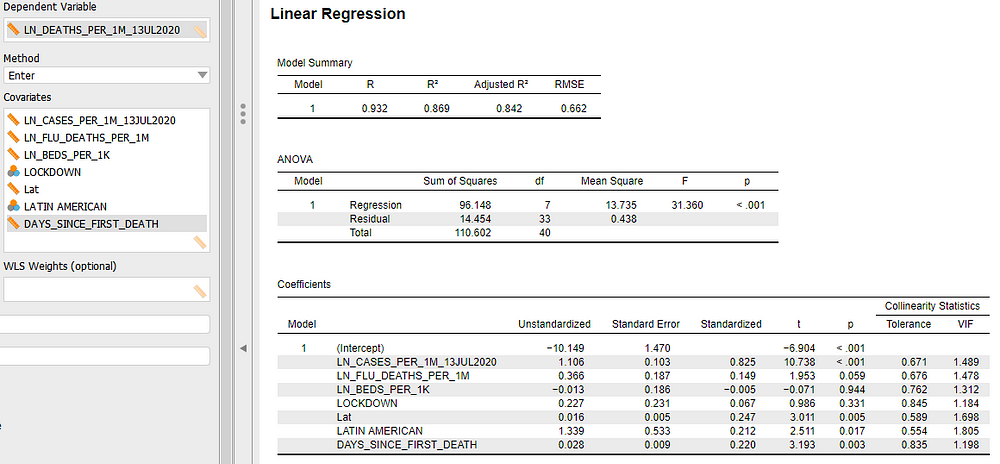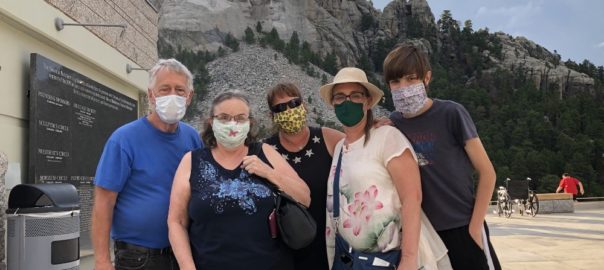By Kent R. Kroeger (Source: NuQum.com; July 19, 2020)
Key Takeaways: The science says we will reach herd immunity — the point at our most vulnerable citizens have indirect protection to the coronavirus (SARS-CoV-2) — when 60 to 70 percent of the population has either been vaccinated or has the virus antibodies having survived contraction of the virus.
At present, while the U.S. is seeing a fast growing percentage of its population who has survived this disease (COVID-19) and therefore bringing the U.S. closer to herd immunity, this growth may be occurring too fast given the country’s medical capacity to handle those most vulnerable to the disease. Based on my models, the U.S. has experienced around 80,000 more deaths than expected given the country’s general characteristics (i.e., population density, days since the virus became lethal, mean latitude, and historical ability to handle the seasonal flu).
Without disciplined individual behavior (i.e,. face masks and physical distancing), the U.S. will continue to suffer more coronavirus deaths than necessary to reach herd immunity.
The U.S. will be talking for “decades” about what New York did to fight the coronavirus, New York Governor Andrew Cuomo recently declared. To further emphasize that point, Cuomo himself designed a campaign poster touting his state’s titanic efforts to control the coronavirus (I purposely use the term ‘titanic’ ):

Criticism of Cuomo’s splatter graph poster is coming from all political corners.
Says the National Review’s Madeleine Kearns: “I don’t have anything nice to say about it, except that it’s a helpful insight into a singularly incompetent and disorganized mind. It must remain one of the weirdest political stunts to come out of a crisis.”
Even CNN — the broadcast home of Governor Cuomo’s own brother, Chris Cuomo — can’t stomach the inappropriateness and arrogance of the New York Governor’s poster art.
“Cuomo’s whimsical gesture was in poor taste and poorly timed,” writes CNN contributor Errol Louis, “New York suffered a staggering 32,000 coronavirus deaths in the span of just a few weeks, more than 10 times the number of lives lost on 9/11.”
With New York’s coronavirus death rate of 1,670 per one million people, what Governor Cuomo wouldn’t give to have Florida’s or Texas’ death rates (211 per/M and 125 per/M, respectively). Indeed, Florida and Texas could see their deaths rates triple over the next month and they still wouldn’t be close to the carnage experienced in New York (or New Jersey) over a much shorter period of time.
Governor Cuomo is smart to focus attention on the past month of relatively few new coronavirus cases or deaths in his state, as the art of politics has at least one immutable law: when a statistical measure doesn’t give the answer you want, use a different measure.
The Republicans are not innocent
Of course, the Donald Trump administration and the Republicans are no better.
The ongoing pissing match between Dr. Anthony Fauci, Director of the National Institute of Allergy and Infectious Diseases, and Peter Navarro, an assistant to the president, spotlights how the Trump administration is cherry-picking coronavirus data for its own political convenience.
In a recent political event — directly contradicting statements by President Trump promoting the declining case mortality rate of the coronavirus — Fauci said “that it’s a false narrative to take comfort in a lower rate of death” and the country cannot get into a “false complacency” regarding progress made in controlling the virus.
Navarro shot back at Fauci in a USA Today editorial: “Fauci says a falling mortality rate doesn’t matter when it is the single most important statistic to help guide the pace of our economic reopening. The lower the mortality rate, the faster and more we can open. So when you ask me whether I listen to Dr. Fauci’s advice, my answer is: only with skepticism and caution.”
So who is right? Fauci or Navarro?
In truth, they are both right…and both wrong.
As reported weeks ago by myself and others, the falling coronavirus case mortality rates are real and significant. Axios, perhaps the most anti-Trump rag on the web, concluded the decline is a function of: (1) a drop in the mean age of Americans getting infected (i.e., a higher percentage of those infected are healthy and capable of surviving the virus), and (2) the “treatments and therapies for those with advanced coronavirus symptoms have improved in the U.S.”
To the extent the Trump administration can take partial credit for the latter reason is debatable, but there is some merit to the argument. The U.S. buying up a large percentage of the world supply of Gilead’s Covid-19 drug Remdesivir, an effective treatment for the disease, is one example — though somewhat ruthless given that this is a global pandemic, not just an American crisis. America First, I suppose.
Still, by trumpeting (pardon the pun) the declining case mortality rate, the Trump administration is only acknowledging half of the story. The U.S. is also experiencing an unprecedented surge in new coronavirus cases — and that surge is not solely a function of increased testing, as suggested by the Trump administration.
Yes, the case fatality rate is falling (a good thing), but with more Americans getting the virus, more Americans will die (a bad thing) — more importantly, many of those deaths will be needless, as I will demonstrate below.
Contracting the coronavirus is not necessarily a bad thing
The American public is bludgeoned with daily updates on new coronavirus cases and deaths. What the news media rarely does, however, is put those statistics in their proper context.
Not every new case of the coronavirus is bad. To the contrary, there is a strong epidemiological argument that the spread of the virus among healthy people serves the important purpose of advancing society towards herd immunity levels — particularly since, according to the University of Minnesota’s Michael Osterholm, PhD, MPH, one of the nation’s leading epidemiologists, we cannot assume an effective vaccine will be widely available any time soon or that, once available, it will offer anything more than short term protection.
“One of the things we have to understand is that this virus is operating under the laws of physics, chemistry, and biology. It doesn’t in any way, shape, or form bend itself to public policy,” Osterholm told Dan Buettner, founder of Blue Zones, a health-oriented website.
The Trump administration’s assumption this virus will go away as soon as a vaccine is developed is both naive and dangerous. It builds expectations in the public mind that will be impossible to meet.
Vaccines don’t just appear at your local doctor’s office or drugstore overnight. The production schedules, supply chains, personnel training, marketing campaigns, and standing up of vaccination centers on the global scale required by the coronavirus will push the capacity limits of even the most advanced countries.
The U.S. could see the wide distribution of a vaccine later this year and nonetheless need many months to get near herd immunity levels — generally believed to be around 60 to 70 percent of the population. In mid-June, Osterholm told NPR that about 7 percent of the U.S. population had already been infected by the coronavirus.
But critics of the Trump administration, led by congressional Democrats and the news media, are advancing an equally dubious expectation that rational public policy making — such as school/business closures and enforcing face mask and social distancing directives — will stop the spread of the virus; when, in fact, the science tells us such measures can only slow the spread of a virus as infectious as the coronavirus (SARS-CoV-2).
“Protective measures such as limiting travel, avoiding crowds, social distancing, and thorough and frequent handwashing can slow down the development of new COVID-19 cases and reduce the risk of overwhelming the health care system,” according to guidance from the Harvard Medical School.
More ominously, Osterholm’s warning in mid-June that long periods of time with few new cases — such as going on now in the Northeast U.S. — is not necessarily a good thing.
“If cases should disappear over the course of the next six to eight weeks, or at least be greatly reduced, that is not necessarily good news,” according to Osterholm. “It surely seems counterintuitive that we would want cases to happen. I don’t want anybody to get sick, severely ill or die. But if we saw a trough of cases in the next two months, I think that would really tell us that we’re likely to have this big second wave, much like we would see with influenza, which could be much worse.”
“This virus is not going to slow down transmission overall. It may come and go, but it will keep transmitting until we get at least 60 or 70 percent of the population infected and hopefully develop immunity,” adds Osterholm.
In layman terms, it is a good outcome when a healthy person contracts the coronavirus and survives without major health complications — as long as they don’t subsequently pass the virus on to someone who is vulnerable to the disease (i.e., the elderly and those people with serious health problems). In other words, surviving the coronavirus is functionally equivalent to being vaccinated against it. Therefore, the news media’s negative obsession with coronavirus case numbers conveniently ignores the positive aspects of the virus’ spread in the U.S.
However, the alarming number of young Americans in “vacation” states contracting the virus and passing it onto vulnerable Americans should temper any Trump administration assertion that the coronavirus is under control. Without disciplined individual behavior (i.e,. face masks and physical distancing), the U.S. will continue to suffer more coronavirus deaths than necessary to reach herd immunity.
How do the U.S. coronavirus numbers compare to other countries?
Accordingly, I will dispense with the standard recitation of the current coronavirus case and death totals (per 1 million people) relative to other countries. The current numbers can be found at RealClearPolitics.com; and, based on those topline metrics, the U.S. is doing no better or worse than most economically developed countries. But those metrics offer little context or insight.
Are Trump and Navarro right in asserting that the growing U.S. case totals are merely a function of increased testing within the U.S. and the ‘real news’ story is the falling case mortality rate?
Or is Dr. Fauci correct in asserting that the falling case mortality rate is an artifact of the virus’ fast spread and that the metric to watch is the number of new cases?
As the following statistical analysis will try to show, both arguments have merit — but, overall, the relative advantage the U.S. is having in lowering its death rate is being squandered by an excessive number of new cases.
My first statistical model attempts to explain the relative number of coronavirus cases in the world’s most advanced economic countries based on a set of factors known to relate to the spread of the coronavirus: (1) population density, (2) mean latitude, (3) the relative number of coronavirus tests (per 1 million people), (4) number of days since the first confirmed case, and (5) a country’s cultural norms (as defined by Samuel Huntington in his book, Clash of Civilizations).
The linear model results can be found in the appendix below (see Figure A.1).
Based on this model, we see which countries are experiencing more coronavirus cases than expected, given their endemic characteristics. After controlling for those factors listed above, my model suggests Chile, U.S., Sweden, Ireland, Portugal, Spain, Russia, France and Canada have all experienced an excessive number of coronavirus cases (see Figure 1).
The U.S. has almost 7,000 more coronavirus cases per 1 million people than expected.
Figure 1: Excess COVID-19 Cases per 1 Million People (as of 13 July 2020)
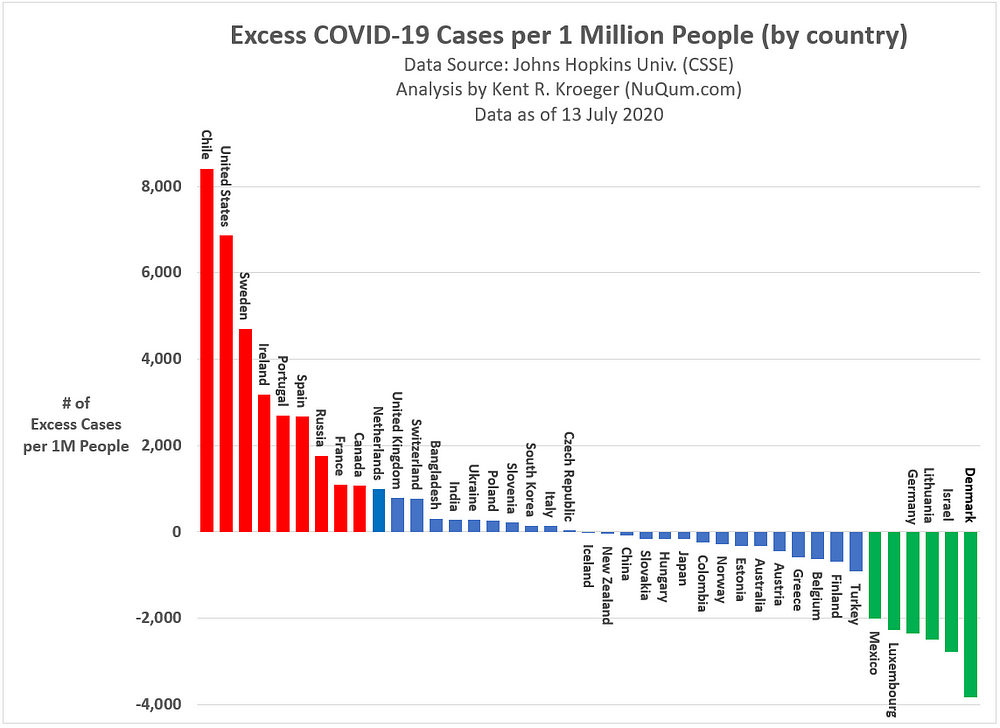
In contrast, countries like Denmark, Israel, Lithuania, Germany, Luxembourg, and Mexico have experienced relatively fewer excessive coronavirus cases.
The hypothesis that these differences are due to nationwide lockdown policies remains unproven. According to the model presented here, there is no strong relationship between whether a country issued a nationwide lockdown and its relative number of coronavirus cases.
In the U.S. case, the Trump administration contends that the recent increase in coronavirus cases is a direct function of significant increases in testing. The administration is partially correct.
The linear model (detailed in Appendix A.1) shows that the strongest correlate with the relative number coronavirus cases is the level of a nation’s testing for the virus. However, testing alone does not explain the current surge in U.S. coronavirus cases.
The current growth in U.S. coronavirus cases (primarily in the southern half of the U.S.) is a function of an increase in testing and the relatively high hit rate of this testing (see Figure 2). Since May 28th, 6.7 percent of U.S. coronavirus tests have returned positive. Only Sweden and Ukraine have reported higher hit rates among the advanced economies. In the same period, the U.S. has increased its cumulative number of testing rate by almost 83,000 tests per million people, the 7th fastest testing growth rate among the 41 advanced economies (behind Luxembourg, UK, Denmark, Singapore, Russia and Israel).
Figure 2: Coronavirus testing hit rates between May 28th and July 13th among advanced economies
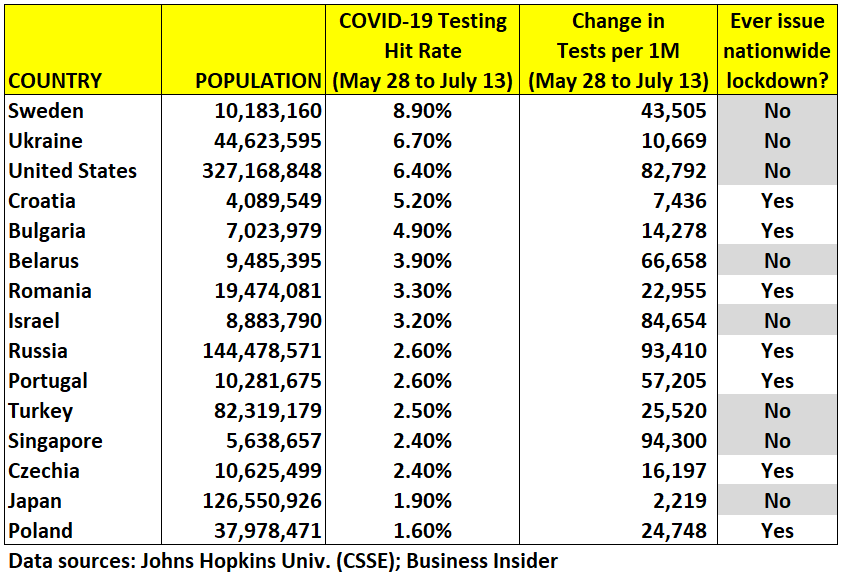
If we merely focus on the recent surge in U.S. coronavirus cases and dismiss the importance of the country’s falling case fatality rate, as Fauci has suggested, we miss a substantial part of the overall picture.
Yes, the U.S. is seeing a surge in new coronavirus cases — a result in part due to a significant increase in cases among young adults — but a growing percentage of these new cases are within relatively healthy population segments more likely to survive COVID-19. Hence, the falling case fatality rate.
But the problem with the Trump administration resting on the falling case fatality rate as conclusive evidence that the U.S. is “beating” the coronavirus is that this too misses the bigger picture.
What if the rise in new cases far exceeds the rate of decline in the case fatality rate? For example, if the recent surge in cases is also overloading hospital ICUs, it is possible people could be dying that wouldn’t have otherwise, despite the falling case fatality rate.
The two trends — cases and deaths — need to be considered together.
In that effort, my second statistical model attempts to explain the relative number of coronavirus deaths in the world’s most advanced economic countries based on a set of factors known to relate to the spread of the coronavirus: (1) the relative number of coronavirus cases (per 1 million people), (2) mean latitude, (3) number of days since the first confirmed death, (4) historical average of annual flu-related deaths (a proxy for the ability of a nation’s health care system to deal with infectious diseases) and (5) a country’s cultural norms (as defined by Samuel Huntington in his book, Clash of Civilizations).
The second linear model results can be found in the appendix below (see Figure A.2).
Based on this second model, we see which countries are experiencing more (and fewer) coronavirus deaths than expected, given their endemic characteristics. After controlling for those factors listed above, my model suggests Belgium, UK, Italy, France, Spain, Netherlands, Mexico and Canada have all experienced more than 100 coronavirus deaths per 1 million people than expected (see Figure 3).
Figure 3: Excess COVID-19 Deaths per 1 Million People (as of 13 July 2020)
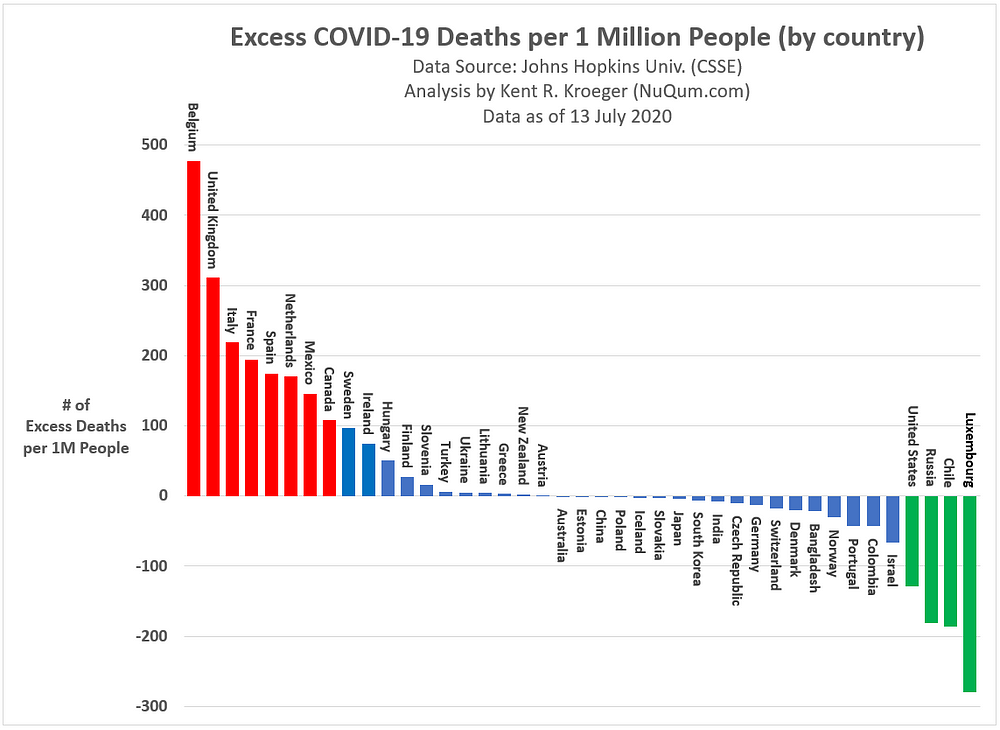
In contrast, Luxembourg, Chile, Russia and U.S. have experienced more than 100 fewer coronavirus deaths per 1 million people than expected — not coincidentally, three of those countries (Chile, Russia, and U.S.) have experienced a higher than expected number of cases per million (see Figure 1 above).
As the Democrats and Republicans cite the coronavirus statistics that best support their political agendas — the Democrats hammer on the growing number of cases and deaths, while the Republicans dutifully trumpet the improving case fatality rate — it would be more productive to combine information on the coronavirus into more comprehensive metrics.
For example, what if we wanted to know what the U.S. coronavirus death rate would be if the country was experiencing its expected number of cases? Recall, in the first linear model (Figures 1 and A.1), the predicted cumulative number of coronavirus cases for the U.S. was 3,866 per 1 million people. In other words, given its underlying characteristics in terms of population density, testing rate, number of days since first case, and mean latitude, how many cases should the U.S. have right now?).
Thus, if we replace the actual number of U.S. deaths (10,732 cases per 1 million people) into the linear model equation of coronavirus deaths (Figures 3 and A.2) with 3,866 cases per 1 million, we get 178 coronavirus deaths per 1 million people. That is the the number of deaths the U.S. would have right now if the country’ s case rate was normal (i.e., predicted value).
Our actual death rate right now is 424 deaths per 1 million. Expanded over the entire U.S. population, as of July 13th, the U.S. has seen approximately 80,500 more deaths than it should have had it kept its coronavirus case rate near normal levels.
Politicizing the coronavirus is counterproductive
The Democrats can legitimately cite the growing number of cases and deaths in the southern half of the U.S. as evidence that state and federal governments are not pursuing effective policies. Conversely, the Trump administration can rightfully claim the coronavirus (and its associated disease, COVID-19) is increasingly survivable, as seen in the falling case fatality rate.
Sadly, but predictably, the coronavirus has been so recklessly politicized by all sides that it has actually done harm to the the U.S. effort to mitigate and suppress the coronavirus.
The coronavirus has exposed our broken health care system and the systemic dishonesty of our political and media elites.
At the same time, the U.S. will survive the coronavirus pandemic of 2020 and most likely see its economy not just recover but flourish in the next 12 months. The ceaseless march of human progress is not going to reverse because of the coronavirus. No disrespect to those who have suffered and/or died from COVID-19, but this virus is not that scary.
Wear a mask, keep your distance, wash your hands, and stop touching yourself
The news continues to be optimistic for the development of a coronavirus vaccine to be available by the end of this year or early next. Three labs, including the U.S. company Moderna, are currently in Phase 3 testing of possible vaccines. The other two labs are in China and the UK.
Tempering this optimism, however, is the reality that COVID-19 cases have surged in Arizona, California, Florida and Texas to such an extent that some ICUs are reaching capacity limits as the daily case and death counts are rising again across the country (see Figure 4).
Figure 4: Daily Case and Death Increases in the U.S. (through 18 July 2020)
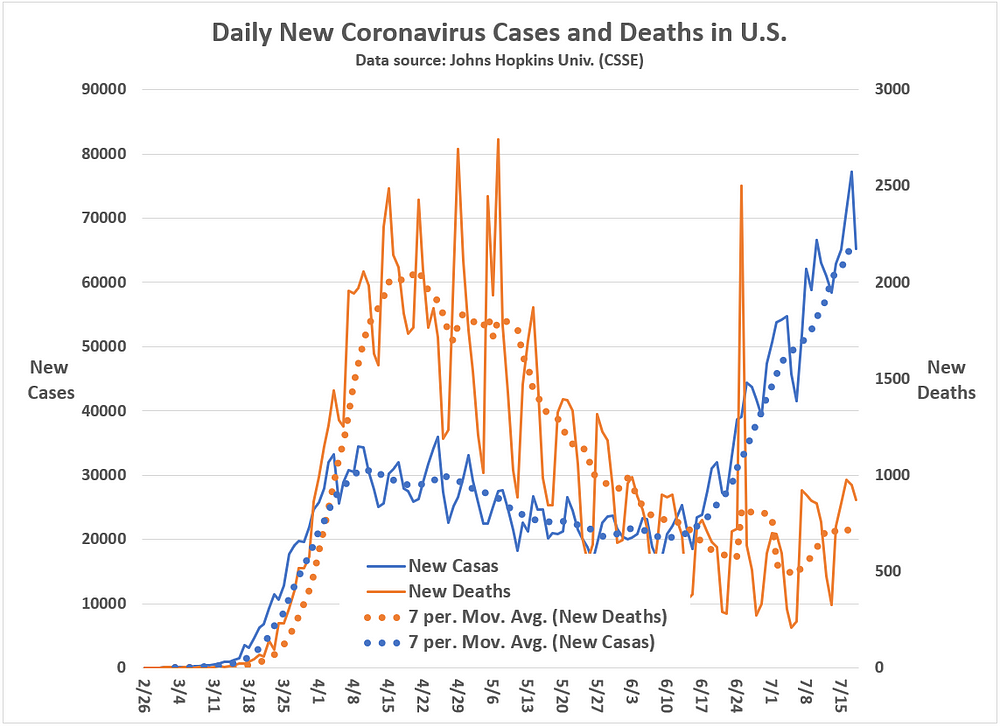
At the same time, as more Americans contract the coronavirus and COVID-19 treatments improve, the cumulative case fatality rate will continue to drop (see Figure 5). That is not a statistical artifact, as suggested by Fauci. It is the result of a virus that is increasingly survivable, as long as we don’t overload our national health care system.
Figure 5: Cumulative Case Fatality Rate in the U.S. (through 18 July 2020)
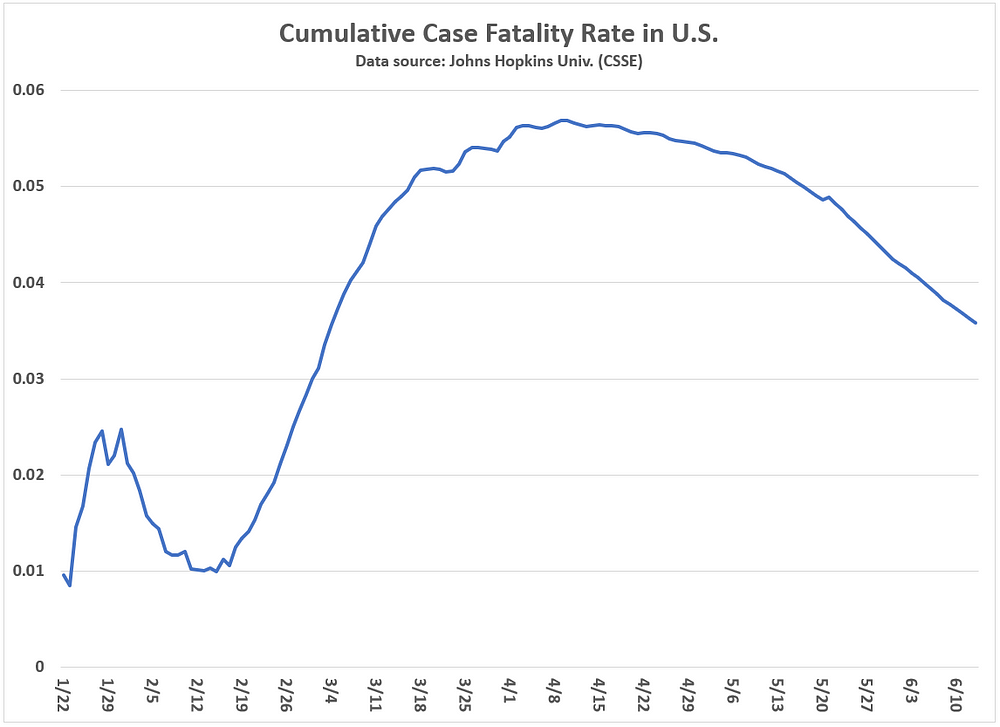
Osterholm warned at the beginning of this pandemic, make no assumptions about when a safe, effective and widely available vaccine will appear. Besides, vaccines are not 100 percent effective and it is unknown how long the eventual SARS-CoV-2 vaccine will protect individuals once administered. Viruses mutate, after all. Furthermore, it is also not clear the extent or how long the SARS-CoV-2 antibodies protect COVID-19 survivors.
What is clear is that the U.S. is going to reach herd immunity through some combination of COVID-19 recoveries and vaccinations. But assuming the U.S. can prevent SARS-CoV-2 infections long enough for a vaccine to be available is foolish and bad public policy.
The goal should be, according to Osterholm, to flatten out the infection curve as much as possible — and that means enforcing sound physical distancing and mask-wearing policies.
However, it is not obvious that shutting down the U.S. economy is necessary or even helpful. And schools may be able to safely re-open as well if Americans — young and old — systematically change some of their everyday behaviors: Wear masks. Wash hands. And avoid close physical contact outside the home.
This is not hard to do. But as one of my Russian friends living here in New Jersey likes to remind me, Americans do not know how to be sick.
That has to change.
- K.R.K.
Send comments to: kroeger98@yahoo.com or tweet me at: @KRobertKroeger1
APPENDIX: The Linear Models for Explaining Worldwide Coronavirus Cases and Deaths (n = 41 countries)
Figure A.1: The Linear Model for Explaining Worldwide COVID-19 Cases (n = 41 countries)
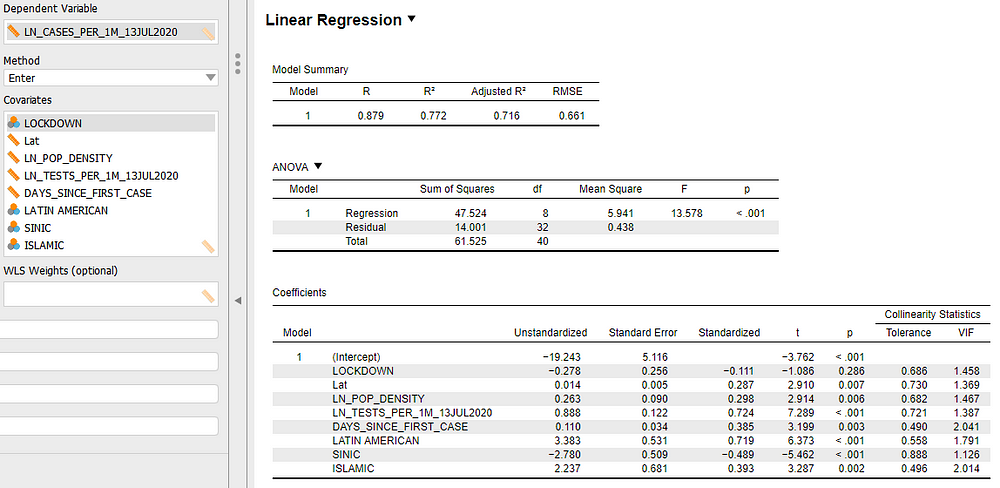
Figure A.2: The Linear Model for Explaining Worldwide COVID-19 Deaths (n = 41 countries)
